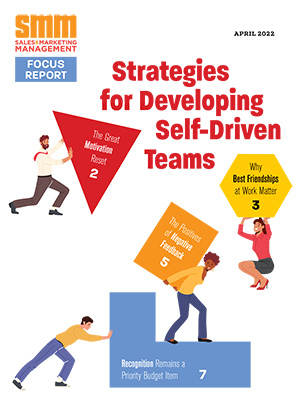“We spent $2 million on a selling system a few years back and our reps won’t put it into play. So we’re looking to drop another $1.5 million on a new program.” A senior sales executive from a major cell phone carrier was talking sales training with me, at a global conference.
“What selling system are you using?” I asked.
Turns out it was one of the top three in existence.
“Can I point something out about your training?” He shrugged, nodded and said he was interested.
“That’s a great selling system. And it works. The problem is the salespeople aren’t using it. That’s on your team. It’s about post-training impact. You don’t solve that by dropping millions more on a new approach. Your fix comes with reinforcing the learning and turning it into new behaviors. It’s crazy that you’re about to repeat the same mistake, which will guarantee the same results (no results).”
He stared a moment and said, “Yeah, we hadn’t really looked at it from that angle.”
No one likes seagull sales training
The irony of this should be evident to anyone reading this tale. People hate seagull salespeople — the ones who show up, drop their load and disappear. Seagull sales trainers are worse. You can almost hear them squawking as they fly away, “Thanks for the money, and good luck with what you bought…”
Yet billions of dollars a year ($11B on sales training in the U.S. alone) are burned on quick training, where your team gets a whole system fire-hosed into their heads over a few days or a week. Then you expect sales to spike.
Maybe if we think and wish and hope and pray, it might come true (thank you, Beach Boys). Three problems are at the root of this issue. One solution eliminates them all. (Note the bolded terms in each bullet):
Most training focuses on learning objectives as the outcome. In the selling world your outcome should be behavior change. Learning objectives? Who cares if you have the smartest sales pros on the planet and they don’t put what they know into practice?
Training should be used to help your salespeople attain mastery of each element of the sales process. By mastery we mean when under pressure, the sales pro can rapidly recall
the right information, adapt it to needs of the situation and then use the right verbal skills to deliver it effectively. This is called rapid adaptive reasoning ability and it is what football quarterbacks and all competitive athletes use — they just call it muscle memory.
Mastery occurs when, after the initial training, you reinforce the experience throughspaced repetition. This is a form of deliberate planned practice, after the event. It is unthinkable that a professional coach would not have the team practice till plays are mastered. It should be just as unthinkable that sales leaders don’t get salespeople enough practice to achieve mastery — demonstrated by behavior change.
The training game-changer
Let’s look into spaced repetition, the game-changer in sales training. What is it? BrainX (BrainX.com) is a company that was engaged in a five-year National Science Foundation (NSF) study on spaced repetition. This has high value for the academic, as well as the professional world. So this data is relevant for young people in school, as well as your students in sales training. The company has trained over 10,000 people — most of them salespeople.
Results of the research: Mastery is formed by testing reps a certain number of times, within a certain amount of days between each of these test sessions. These tests are short, only 15 minutes at a time.
I have trained, coached and consulted from Vietnam to Venezuela. I’m building out a gaming tool now for salespeople. So when I was introduced to Bruce Lewolt, the CEO of BrainX, I realized there was something special about what he had created.
Lewolt insists we need to slow down our training by “chunking down” each skill set or knowledge set into small pieces. Once you get laser-focused on smaller bits of information, you can use spaced repetition to gain mastery before moving on to more sales training content. This helps
the brain reprogram new information. We know the brain can get stronger and grow, just like muscles do when you’re in a weight-training program.
BrainX also assesses each salesperson on your team and offers customized training, based on what each one needs. This is distinct from traditional training, which moves learners through the sales process chronologically, often quickly (the fire hose effect).
I was both shocked and excited about this. Because my most successful training intervention was a three-year period I spent with a Blue Cross team of 15 reps. I only taught one step of the sales process, every 60 days, until everyone got it and could move on. It was a high-risk consulting relationship because I was slowing down how I trained, which meant I was slowing down how I got paid. But the results delighted everyone (including my wife — also a trainer — who was questioning why I’d work so hard for a lot less money).
Along comes BrainX who says we’ve digitized this whole idea and now you can train larger sales teams and gain mastery, first by slowing down and next by employing spaced repetition.
Lewolt shares a crazy (OK, embarrassing) story about how the U.S. Navy adopted an online training system where sailors all received 100 percent on final exams. But there was no spaced repetition offered to reactivate memory. Several weeks later, when they arrived at their assignments, these learners couldn’t even remember components of the systems, much less operate the equipment. The report revealed such a serious readiness problem that it was classified top secret for over a year while the problem was being solved.
Questions are the answer
So what is this spaced repetition composed of? Questions! They are personalized to each learner, repeated at specific day intervals and they get progressively more difficult at a rate that constantly challenges the learner. In my experience, great sales pros are defined by their questions. So it’s no surprise that the use of questions in learning can be equally rewarding.
Revisiting content is best done with fill-in-the-blank questions or short answer formats. Multiple choice questions (while popular in school and work testing environments) can be detrimental to learning. How? Students only have to recognize correct answers. And wrong or near-wrong answers can be a distraction to the brain’s ability to remember and attain mastery.
These 15-minute reactivation experiences are employed only three to five times on each skill or knowledge set, over a space of a few weeks, when the proper spacing strategy is employed. Without personalized spacing, nine to 15 repetitions are required to reach the same level of mastery. A small time investment produces a big payoff.
Some companies are using these quick sessions for daily review, before sales calls. In one study their success rate on their first five calls increased by 22 percent compared to the days when they didn’t do a practice session.
You now have the secret to potent training. You can redesign your existing sales training, in order to improve team performance and attain mastery. Your keys:
- Slow down training
- Chunk down training content
- Adopt spaced repetition to reactivate learning
- Create questions for 15-minute reinforcement experiences
- Watch how your sales pros’ mastery makes you money
Dan Seidman was awarded the International Sales Training Leader of the Year in 2013. His body of work can be found in The Ultimate Guide to Sales Training, an encyclopedia of best-practices on every piece of the sales puzzle. Contact him at Dan@GotInfluenceInc.com or at 847-359-7860.


